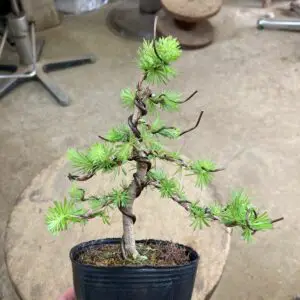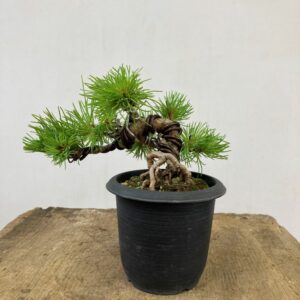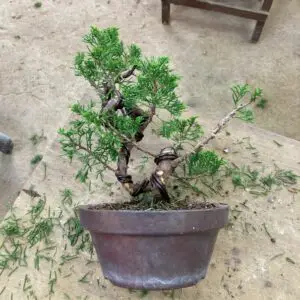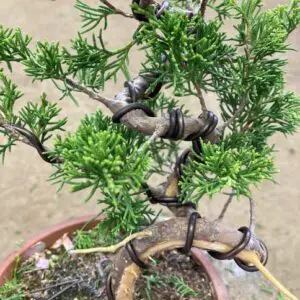Not all wires are suitable for bonsai styling and the top bonsai wire choices are aluminum or copper. Bonsai wire should be flexible, non-elastic, heat-insulating, visually complementing, non-toxic and affordable.
Introduction to bonsai wire

Bonsai wiring
Role of bonsai wire
What is the bonsai wiring technique
One of the essential techniques for bonsai styling is wiring, besides pruning.
Bonsai wiring involves wrapping wires around the trunk, branches, and roots, to create the fundamental shape of a bonsai tree. Wiring is the most effective and accurate technique among the methods of shaping bonsai trees.
Purpose of bonsai wiring
The primary purpose of bonsai wiring is to form a tree in a desirable shape as a bonsai by bending and stretching branches and trunks to an angle, direction, and shape. With the application of wire, the possibilities for tree manipulation become limitless, which simply cannot be attained by just pruning the tree.
Also, wiring is necessary to make a younger tree appear aged. An old tree tends to have its branches growing downward, in contrast to younger trees whose branches grow in an upward direction. By wiring branches downward, a bonsai tree can mimic an appearance of an old tree.
History of bonsai wiring
The bonsai wiring technique has a relatively short history in the long history of bonsai. It began about 120 years ago when, by chance, a bonsai grower found a pine tree shipped from Osaka to Tokyo. The branches of this tree were wired to prevent them from being broken while shipping but the bonsai grower found that wiring can shape a tree in the desired form freely and very easily.
Since then, it is widely practiced to shape all kinds of bonsai trees.
Why choosing the right wire matters
Wiring a bonsai, however, is more difficult than other shaping techniques. While it grants artistic control, doing it carelessly won’t achieve your desired goal. If you chose the wrong one, the wire won’t work at all or can lead to injury or scarring of the tree.
So, understanding the types of wire available and their properties for proper application is crucial to successful bonsai styling.
Importance of choosing the right wire
Choosing the right wire for bonsai is important because it directly impacts the effect, health, and overall aesthetic of your bonsai tree. Here’s why selecting the appropriate wire is crucial and what may happen if you choose the wrong wire.
Proper shaping and training
Bonsai wire is used for shaping and training the branches and the trunk of the tree. Choosing the right wire enables the application of a necessary amount of pressure to guide the branches/trunks into desired positions without causing unnecessary stress or damage to the tree.
If you chose the wrong wire, it may be too weak to hold the branches/trunks in place, leading to inadequate shaping. Or, it may create unnecessary pressure if the wire is too hard, causing damage to the tree or hindering its growth.
Preventing wire damage
As you can imagine, wiring is very stressful for bonsai trees, and using the wrong wire can potentially harm the tree.
If the wire is too hard or not strong enough, it may cut into the bark because it is too firm for the bark or needs extra strength for bending, leading to injury and scarring. This can obstruct the tree’s growth and create scars that can possibly never heal, at least in our lifetime.
Selecting the right wire minimizes the risk of wire damage and ensures the well-being of your bonsai tree.
Keeping aesthetics
The wire used in bonsai styling will be visible on the tree until it is removed, and so, it should complement the overall aesthetics of the tree. Choosing wire that blends well with the tree’s bark texture and foliage will help not get in the way of the natural appearance of your bonsai trees and their visual appeal.
Types of bonsai wire

Wiring Japanese white pine
Suitable wire for bonsai
Not all materials are suitable for bonsai wire. Bonsai wire is specifically designed to have certain characteristics that make it well-suited for shaping and training bonsai trees. Here are a few key considerations for good bonsai wire.
Flexible and easy to use
Bonsai wire should have sufficient flexibility for shaping and bending the branches without excessive resistance. It should be pliable enough for you to achieve the desired curves and angles with ease and be convenient to use during the wiring process.
Non-elastic
Elasticity refers to the wire’s tendency to return to its original shape after being bent or stretched.
In bonsai, it is important that the wire holds its position firmly without springing back. If the wire is elastic, it may not provide the necessary support to hold the branches/trunks in the desired position, making it difficult to shape the tree effectively.
Visually complementing
The appearance of the wire is also important as it stays on your tree for at least a couple of months to several years. Ideally, the wire should be brownish like tree bark and have a dull surface that can blend with the tree.
This helps maintain the visual beauty of the tree while the wire is in place.
Heat insulating
A good bonsai wire should be heat insulating, meaning it would not conduct the heat of the sun. This is important because absorbed heat can potentially damage the tree’s delicate branches, especially at their tips.
Non-toxic
Bonsai wire should be non-toxic to trees. It should not contain harmful substances or chemicals that could negatively impact the health or growth of the tree.
Affordable
Affordability is another consideration when choosing bonsai wire. Wiring is an essential technique for creating a desired bonsai shape. You may be surprised that you need quite a lot and it is often not reusable
Technically, some of the materials of wires may be used again but the lengths can be shorter/longer than you need and you have to straighten them up before resuing, which is both inconvenient and time-consuming. I tried once but it wasn’t worth it.
So, a reasonably priced wire is a plus, especially when you are working with multiple trees or need to rewire your bonsai frequently.
Types of popular bonsai wire

Juniper bonsai styling using aluminum wire
There are a few wires that are commonly used in bonsai styling and the top 2 choices are aluminum and copper.
Aluminum Wire
Aluminum wire is one of the best choices and is popular among bonsai growers due to its affordability and ease of use. Though heat conductive, it is lightweight, easily pliable, corrosion-resistant and fairly non-elastic, making it ideal for shaping and training bonsai trees.
I think the aluminum wire is especially good for beginners because it can bend and rebend again and again, allowing us to make changes in shaping, unlike copper wires.
Copper wire
Copper wire has been traditionally used for bonsai styling and is another good option. It offers greater strength compared to aluminum wire, making it suitable for thicker branches or trees with more rigid growth patterns.
On the other hand, copper wire is harder to wrap around branches and trunks due to its greater strength. Usually, it needs annealing (heat treatment) before use to make it easier to handle. And once it is bent in one direction, it is very difficult to rebend it into different shapes without applying a significant amount of force (this phenomenon is called “work hardening”).
Copper wire thus is not beginner friendly. Unless you are experienced and how to style bonsai without fail, I think aluminum wire is a better choice.
Alternative wires for bonsai

Juniper bonsai styling
While aluminum and copper wires are the traditional and widely used tool for shaping and training bonsai trees, there are a few alternative options as well.
Steel wire
A steel wire can be used for bonsai but I don’t recommend it. Steel is harder and less flexible than copper, which is already hard enough to handle. Steel wire is extremely challenging to work with when shaping and bending bonsai branches.
The only good thing about steel wire is its low price but other than that, it isn’t good enough for bonsai wire.
String or Raffia
In some cases, paper string or raffia are used for bonsai training but not for shaping purposes. These materials are very flexible and can be wrapped around branches for protection from hard bent using copper or aluminum wires.
To use as an alternative for bonsai wire, paper string and raffia lack rigidity and strength for shaping and styling. They are best utilized for gentle support or as supplementary aids alongside wire.
Garden wire
The garden wire is not good for bonsai styling. A lot of garden wires in the market are made of rubber or other oil derivatives, which are too flexible and elastic as bonsai wire. They just don’t have the ability to shape the tree in the desired style.
There are garden wires that are made of steel. In this case, it can be used as bonsai wire but is very hard to handle.
Electrical wire
Electrical wire cannot be used as bonsai wire because it may not possess the same level of flexibility or ease of use as dedicated bonsai wire and/or the necessary strength to hold the branches/trunks in a desired shape. After all, it is intended to be used for entirely different purposes.
I think it is better to use dedicated bonsai wire than using electrical wire, which is specifically designed for the purpose of shaping and training bonsai trees.
My thoughts on alternative bonsai wires
While all these alternatives above offer some benefits in shaping and training bonsai trees, they may not provide the same level of control, strength, or longevity as traditional bonsai wire. For most cases, I think aluminum or copper bonsai training wires achieve precise shaping and fit training purposes as they are specifically designed for these tasks.



